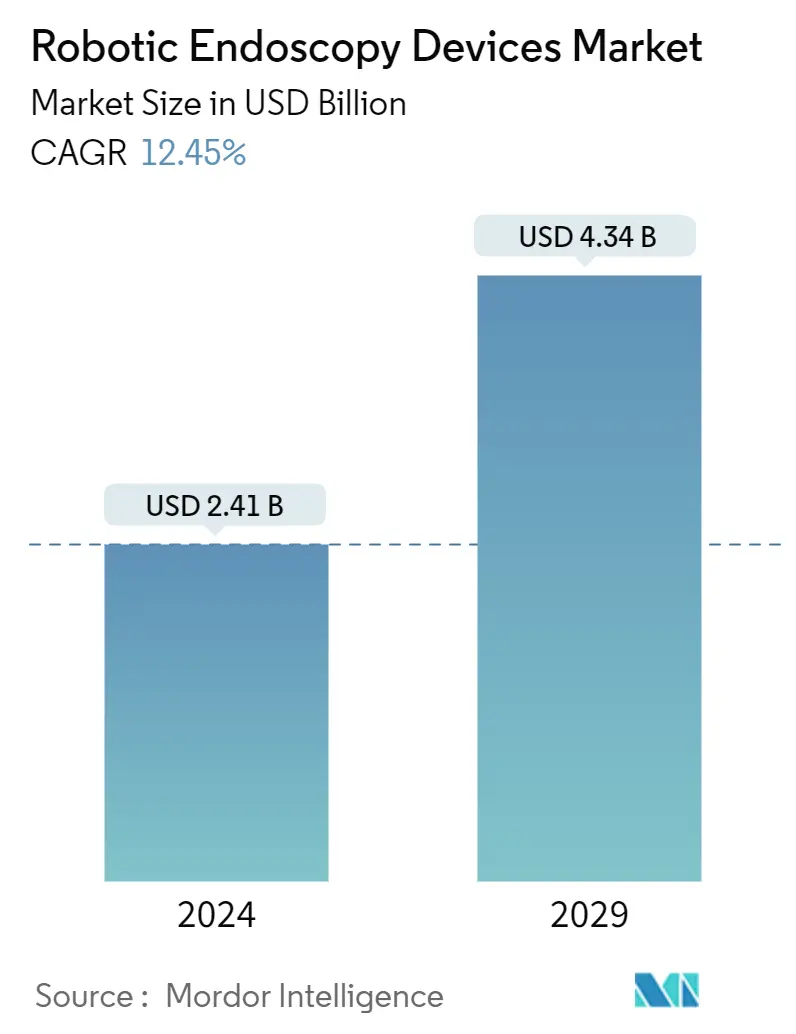Market Size of Robotic Endoscopy Devices Industry

| Study Period | 2019 - 2029 |
| Market Size (2024) | USD 2.41 Billion |
| Market Size (2029) | USD 4.34 Billion |
| CAGR (2024 - 2029) | 12.45 % |
| Fastest Growing Market | Asia Pacific |
| Largest Market | North America |
Major Players
*Disclaimer: Major Players sorted in no particular order |
Need a report that reflects how COVID-19 has impacted this market and its growth?
Robotic Endoscopy Devices Market Analysis
The Robotic Endoscopy Devices Market size is estimated at USD 2.41 billion in 2024, and is expected to reach USD 4.34 billion by 2029, growing at a CAGR of 12.45% during the forecast period (2024-2029).
The COVID-19 pandemic has significantly impacted the robotic endoscopic devices market. The global lockdowns decreased public mobility and significantly impacted the diagnostics and imaging industry. The diagnostic procedures and screening programs, which were non-immediate, were postponed to decrease the burden on healthcare infrastructure. For instance, the article published by UCL in March 2021 mentioned that by January 2021, a backlog of nearly half a million endoscopic procedures, which were essential for diagnosing gastrointestinal cancers and diseases, was built up during the COVID-19 pandemic.
The article also mentioned that the number of endoscopies after the lockdown in the United Kingdom fell by more than 90%. Such a drastic reduction in endoscopic procedures due to the strict lockdown regulations had a notable impact on the growth of the market. However, as the lockdowns were eased in most countries, robotic and conventional endoscopic procedures experienced greater momentum. The market is expected to grow at a significant rate during the forecast period.
The major factors contributing to the market's growth are the rising prevalence of chronic diseases, such as pancreatic cancer, inflammatory bowel disease, and gastroesophageal reflux disease (GERD), among people of all age groups due to unhealthy lifestyles. As per the International Foundation for Gastrointestinal Disorders (IFFGD), published in February 2021, 10%-15% of the global population was affected by irritable bowel syndrome at that time. About 25-45 million people were afflicted with the disease in the United States, necessitating a high requirement for advanced technologies in endoscopy.
According to a report published by the Centers for Disease Control and Prevention (CDC) on World IBD Day (May 19, 2021), about 7 million around the world suffer from IBD. The report also stated that the rate of prevalence of the disease has significantly increased during the last two decades. Robotic endoscopy for patients with IBD is feasible, safe, and improves clinical and surgical outcomes. Such benefits of robotic endoscopy in diagnosing irritable bowel syndrome and inflammatory bowel syndrome are expected to drive the demand, thereby boosting the growth of the market.
Increasing investments in technological innovations in endoscopy visualization systems by various market players are expected to boost the growth of the market during the forecast period. For instance, in September 2022, Virtuoso Surgical announced USD 20 million for developing endoscopic surgical robots. The surgeries conducted will include bladder cancer, uterine fibroids, enlarged prostate, central airway obstruction removal, and endoscopic neurosurgery, among others.
However, highly expensive surgical endoscopic procedures, troublesome repayment approaches, and stringent regulatory reforms are expected to restrain the growth of the market during the forecast period.
